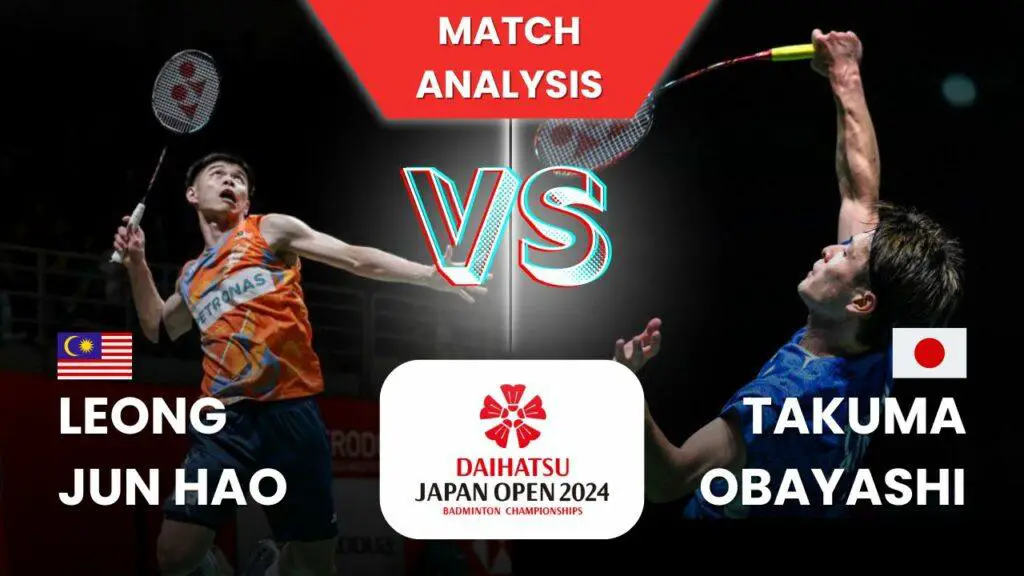[transcript]
Hey guys, today we will be breaking down Takuma Obayashi and Leong Jun Hao’s match at the 2024 Daihatsu Japan Open.
In their previous meeting, played at the 2023 Kumamoto Japan Masters, Takuma Obayashi won in two straight sets, 23-21, 21-16. Obayashi was able to play proactively and anticipate shots that Leong Jun Hao would make.
In the 2024 Japan Open, Leong Jun Hao played relatively the same way. However, his shot quality has noticeably improved, as well as his shot selection.
Another thing that would play in Leong Jun Hao’s favour were the unforced errors from Takuma Obayashi.
The first game of both tournaments, Obayashi would average around 10 unforced errors. This is around 47.6% of the points that Leong Jun Hao would win.
However, in the second game of the Kumamoto Japan Masters, Obayashi would make only 3 out of 16, which equates to 18.8% of the points earned from Leong Jun Hao.
This is almost a 30% difference from the recent Japan Open, where Obayashi would commit 10 unforced errors again, making up 47.6% of the points earned by Leong Jun Hao.
Let’s jump into how Leong Jun Hao beat Obayashi.
—
Obayashi is an extremely fast player who excels at his attacking play.
To counter this, Leong Jun Hao played a four corner style, playing deeper and higher lifts that prevented Obayashi from using his speed.
Leong Jun Hao also had many unexpected shots on his defense which caused Obayashi to mistime his split step. These defensive shots prevented Obayashi from playing his combos.
Leong Jun Hao’s main strategy was to control Obayashi in the backcourt and punish predictable shots via many pace changes and direction changes.
In the first two rallies of the game, we can already see the difference in the movement between the two players. Leong Jun Hao is a lot more controlled whereas Obayashi is more rushed.
The reason the Malaysian is able to play like this is because of his shot quality.
You can see how his lifts are almost always to the backlines with good height.
This makes it very difficult for Obayashi to capitalize. He must continue to play neutral shots until he sees an opportunity.
However, this is what gave Leong Jun Hao an edge over Obayashi.
The Japanese shuttler would play neutral half smashes from his around the head that would get capitalized by Leong Jun Hao.
Obayashi does not have many options from that around the head corner, opting mainly for the half smash straight, which is why Leong Jun Hao could almost always read it right.
Because these half smashes weren’t accurate enough, and sometimes too obvious, the Malaysian had full control and could inject speed and change the direction.
Another reason that allowed the Malaysian to be more controlled over the Japanese, was because of his footwork.
Notice the difference in the two’s footworks. While both have their advantages and disadvantages, Leong Jun Hao was able to execute his split step timing very well, which made him move around the court very fluidly, a lot like his fellow Malaysian, Lee Chong Wei.
Obayashi’s footwork is more like a boxer. He is very bouncy on the balls of his feet, but always bouncing around makes it harder to time the split step, especially when the opponent plays deceptions.
Takuma does make a few adjustments that ultimately help him to comeback a little.
Since Leong Jun Hao is trying to slow down the pace of the game, Obayashi must make sure not follow the Malaysian’s rhythm, which is very difficult given that Leong Jun Hao’s shot quality was superior on that given day.
However, Obayashi must try to change the pace in his favor, by playing unexpected shots such as, slow rhythm but fast shot, or a change in direction with a slice or punch clear. The point is to knock Leong Jun Hao’s balance off, and follow up his next shot with a combo.
We can see some examples of where Obayashi does this brilliantly.
It seems that before this match, Leong Jun Hao discussed with his coach about Obayashi, and they pointed out a weak around the head and backhand from the Japanese shuttler.
The Malaysian would repeatedly send the shuttle to Obayashi’s backhand, sometimes 3 to 4 times in a row.
And the reply from the Japanese player wouldn’t be anything that Leong Jun Hao wasn’t ready for. The Malaysian was extremely prepared in defense, covering mostly the midcourt and backcourt.
A lack of slices or tight but fast drop shots from Obayashi allowed Leong Jun Hao to close down the court and make it feel smaller. This is why he was able to defend so many of these full powered smashes from Obayashi.
Just take a look at how far he is standing!
It is evident that, on that given day, Leong Jun Hao was the better player and we are excited to see if he can keep this form going into his next games.
Stay tuned to see our analysis of his upcoming matches!
If you guys liked this video, please like and subscribe so you don’t miss out on any new content.

